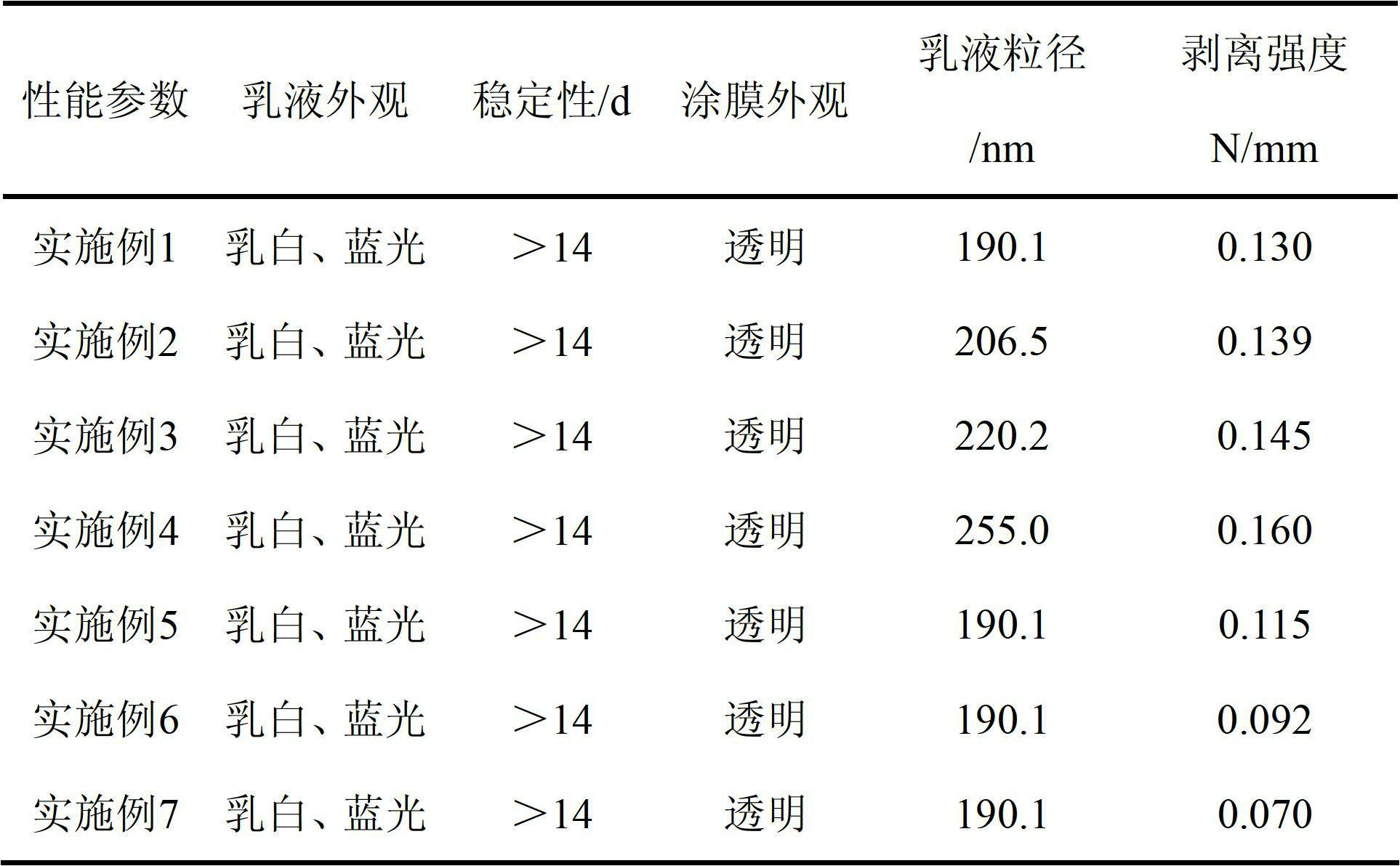Preparation method of water-borne long-chain acrylate separant
A technology of acrylates and release agents, applied in coatings and other directions, can solve the problems of late start of the theory of mini-emulsion polymerization, and the application field has not been fully developed. Effect
- Summary
- Abstract
- Description
- Claims
- Application Information
AI Technical Summary
Problems solved by technology
Method used
Image
Examples
Embodiment 1
[0031] (1) Weigh raw materials according to the following weight percentages: deionized water 50%, lauryl methacrylate 9.8%, isobornyl acrylate 9.8%, methyl methacrylate 8.2%, butyl acrylate 8.2%, acrylonitrile 5.9% , acrylic acid 5.1%, sodium lauryl sulfate 1%, sodium bicarbonate 1%, ammonium persulfate 0.5%, sodium persulfate 0.5%;
[0032] (2) Add deionized water, lauryl methacrylate, isobornyl acrylate, methyl methacrylate, butyl acrylate, acrylonitrile, acrylic acid, sodium lauryl sulfate, and sodium bicarbonate into a beaker at 50°C Stir for 20min under the condition to prepare the pre-emulsion A;
[0033] (3) Place the pre-emulsion A in an ultrasonic cell pulverizer and emulsify it in an ice-water bath for 5 minutes to prepare the mini-emulsion B;
[0034] (4) Pour the above-mentioned miniemulsion B into a four-necked flask equipped with a stirrer, a condenser, a nitrogen passage, and a thermometer. After raising the temperature to 75°C, add ammonium persulfate and sod...
Embodiment 2
[0038] (1) Weigh raw materials according to the following weight percentages: 50% deionized water, 9.8% lauryl methacrylate, 9.8% octadecyl methacrylate, 8.2% methyl methacrylate, 8.2% butyl acrylate, Styrene 5.9%, acrylic acid 5.1%, sodium dodecyl sulfonate 1%, sodium bicarbonate 1%, sodium persulfate 0.3%, ammonium persulfate 0.5%, potassium persulfate 0.4%;
[0039] (2) Add deionized water, lauryl methacrylate, octadecyl methacrylate, methyl methacrylate, butyl acrylate, styrene, acrylic acid, sodium lauryl sulfonate, carbonic acid Sodium hydrogen, stirred at 50°C for 30 minutes to prepare pre-emulsion A;
[0040] (3) Place pre-emulsion A in an ultrasonic cell pulverizer and emulsify for 5 minutes in an ice-water bath to prepare fine emulsion B;
[0041] (4) Pour the above microemulsion B into a four-neck flask equipped with a stirrer, a condenser, a nitrogen passage, and a thermometer. After heating up to 80°C, add sodium persulfate, ammonium persulfate and potassium pers...
Embodiment 3
[0044] (1) Weigh raw materials according to the following weight percentages: 60% deionized water, 11% lauryl methacrylate, 12.5% octadecyl acrylate, 8.6% butyl acrylate, 5.9% styrene, 1.1% acrylic acid, ten Hexaalkyl sodium sulfate 0.3%, sodium bicarbonate 0.3%, ammonium persulfate 0.3%;
[0045] (2) Add in a beaker, deionized water, lauryl methacrylate, stearyl acrylate, butyl acrylate, styrene, acrylic acid, sodium cetyl sulfate, sodium bicarbonate, at 45 ° C Stir for 35min to prepare pre-emulsion A;
[0046] (3) Place the pre-emulsion A in an ultrasonic cell pulverizer and emulsify it in an ice-water bath for 5 minutes to prepare the mini-emulsion B;
[0047] (4) Pour the above-mentioned miniemulsion B into a four-necked flask equipped with a stirrer, a condenser, a nitrogen passage, and a thermometer. After heating up to 85°C, add ammonium persulfate and keep it warm for 7 hours to obtain a long-chain acrylate release agent. .
[0048] The method for testing the rele...
PUM
 Login to View More
Login to View More Abstract
Description
Claims
Application Information
 Login to View More
Login to View More - R&D
- Intellectual Property
- Life Sciences
- Materials
- Tech Scout
- Unparalleled Data Quality
- Higher Quality Content
- 60% Fewer Hallucinations
Browse by: Latest US Patents, China's latest patents, Technical Efficacy Thesaurus, Application Domain, Technology Topic, Popular Technical Reports.
© 2025 PatSnap. All rights reserved.Legal|Privacy policy|Modern Slavery Act Transparency Statement|Sitemap|About US| Contact US: help@patsnap.com

